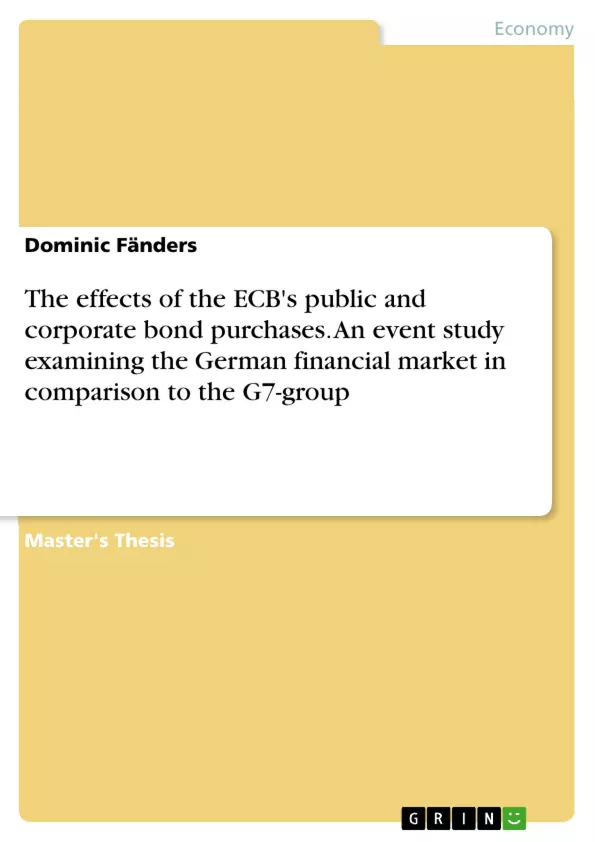This study quantifies the financial market impact of the ECB’s public and corporate bond purchase programs from January 2015 to June 2016. The conducted event study analyses eleven announcement events and their influence on government bonds, corporate bonds, exchange rates and equity markets. The focus lies on the German market, although all other G7 countries are included for reasons of comparison.
These are the main findings: Government bond and corporate bond yields fell by 23bp and 32bp respectively over all events; the effect on the euro was negative but weak; and the euro equity markets were positively driven by 680bp. Furthermore, most of the effects occur on the day following the events. Finally, the news impact diminishes over time, causing an observable break between the public and corporate bond purchase program.
Inhaltsverzeichnis (Table of Contents)
- Introduction
- Literature review & background
- Channels through which QE influences prices.
- Study layouts used in previous work.
- Findings of previous research.
- Spill-over effect on other assets.
- Positioning of this dissertation within the existing work...
- Quantitative Easing of the European Central Bank.
- Methodology
- Data.
- Results.
- Government bonds
- Corporate bonds.
- Currencies
- Equity markets.
- Conclusion
- References..
- Appendix.......
Zielsetzung und Themenschwerpunkte (Objectives and Key Themes)
This dissertation aims to quantify the financial market impact of the European Central Bank's (ECB) public and corporate bond purchase programs from January 2015 to June 2016. It analyzes eleven announcement events and their influence on government bonds, corporate bonds, exchange rates, and equity markets, focusing on the German market with comparisons to other G7 countries.
- Financial market impact of the ECB's bond purchase programs
- Event study analysis of announcement events
- Influence on government bonds, corporate bonds, exchange rates, and equity markets
- Comparison of the German market to other G7 countries
- Short-term and long-term impacts of the ECB's policies
Zusammenfassung der Kapitel (Chapter Summaries)
- Introduction: This chapter provides an overview of the context surrounding the ECB's bond purchase programs, including the post-financial crisis environment and the need for accommodative monetary policy. It also outlines the study's objectives and methodology.
- Literature review & background: This chapter reviews existing research on the effects of quantitative easing (QE) programs, examining the channels through which QE influences prices, the methodologies used in previous studies, and findings on the spill-over effects of QE on other assets. The chapter positions this dissertation within the broader body of work on QE.
- Quantitative Easing of the European Central Bank: This chapter provides a detailed overview of the ECB's QE program, discussing the context, motivations, and implementation of the program.
- Methodology: This chapter outlines the event study methodology employed in the dissertation, describing the data sources and the specific methods used to analyze the announcement events.
- Results: This chapter presents the findings of the event study analysis, examining the effects of the announcement events on government bonds, corporate bonds, currencies, and equity markets.
Schlüsselwörter (Keywords)
This dissertation focuses on the financial market impact of the European Central Bank's quantitative easing (QE) program, specifically its public and corporate bond purchases. Key terms include event study analysis, government bonds, corporate bonds, exchange rates, equity markets, German market, G7 countries, and spill-over effects.
- Citation du texte
- Dominic Fänders (Auteur), 2016, The effects of the ECB's public and corporate bond purchases. An event study examining the German financial market in comparison to the G7-group, Munich, GRIN Verlag, https://www.grin.com/document/434665



